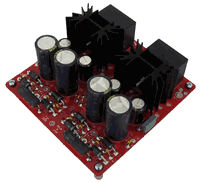GlassWare Audio Design
Thanks for Supporting the Tube CAD JournalNew Balancer PCB and Kit
New Low-Voltage and High-Voltage Regulator Kits

DANGER! High-voltage power supplies contain lethal voltages and currents; thus, a real—and possibly—lethal shock hazard exists.
Ideally, a variac should be used to slowly power up the regulator, as it is better to have a mis-oriented electrolytic capacitor or a mis-located resistor blow at low voltages, rather than at high voltages. Remember that the danger increases by the square of the voltage; for example, 200 volts is four times more dangerous than 100 volts and 400 volts is sixteen times more dangerous.
Once the power supply is powered up, be cautious at all times. In fact, even when the power supply is disconnected or shut down, assume that power-supply capacitors will have retained their charge and, thus, can still shock. If you are not an experienced electrical practitioner, before attaching the transformer windings to the board, have someone who is well-experienced in electronics review your work.
There are too few tube-loving solder slingers left; we cannot afford to lose any more.

